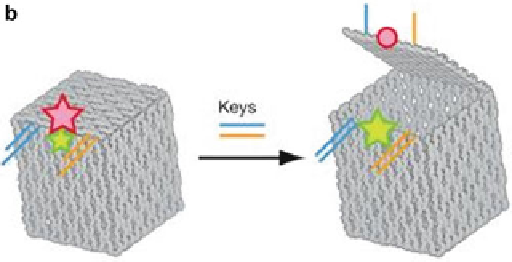Biomedical Engineering Reference
In-Depth Information
Fig. 15.9
The controlled opening of the box lid (Reprinted by permission from Macmillan
Publishers Ltd: Nature, Ref. [
18
], copyright 2009)
which might indicate either the dissociation of the CpGs from the carrier tubes or a
partial disassembly of the DNA nanotubes within the endosome. Another concern
is that they also detected some level of immunostimulatory effects for DNA origami
nanotubes even without the addition of CpGs, though not through Toll-like receptor
9 (TLR9) pathways. For further application of this DNA origami nanotube, the
covalent-linking method might need to use to attach CpGs or other drugs to the
DNA origami nanotube structures, and optimization for the DNA nanotube structure
might also needed to increase its stability and to avoid the unwanted effects.
Also, for most cases, it is desirable to have a multifunctional drug nanocarriers
that contain targeting ligands, drugs, and imaging agents at the same time; also it is
important for delivery system to have the function of controlled release of the drugs,
that is, the drugs were first encapsulated inside a cage-like nanocarrier structure and
will only be released when the nanocarrier gets to the targeted position and receives
specific signals.
Along this purpose, A DNA origami box with a controllable lid was made by
Gothelf and Kjem's group [
18
]. The lid has a dual lock-key system composed
of DNA duplexes with sticky-end extensions as a “toehold”; once “key” oligonu-
cleotides are added to the box solution, the lid will be opened (Fig.
15.9
,Ref.
[
18
]). The close and open operation can be monitored by the FRET efficiency
between two fluorescence dyes, Cy3 and Cy5, attached to the designed position.
This demonstrated the possibility of using DNA nanostructures as controllable
targeting drug delivery systems.
Recently, Douglas' group developed a DNA origami nanorobot [
19
,
20
], with
a hexagonal barrel-shaped cage-like structure. Two domains of the barrel are
covalently attached in the rear by single-stranded scaffold hinges; two specific
DNA aptamer-based locks are created to close the barrel in the front. The two
aptamers form an AND logic gate; once a correct combination of two protein antigen
are met, the aptamers will undergo target-induced switching between an aptamer-
complement duplex and an aptamer-target complex, in turn, open the barrel, and

Search WWH ::

Custom Search